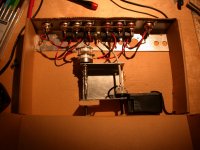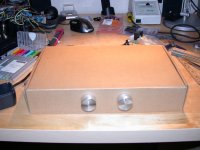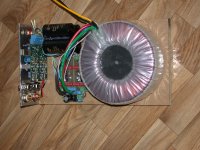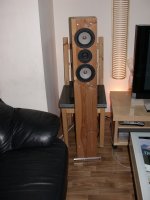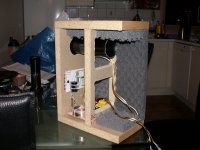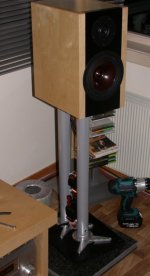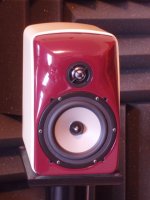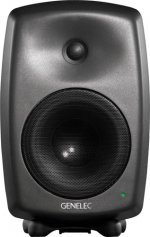Well put, dfidler. Regarding the top edge I added as a side note in an earlier post that that's a tradeoff I'm willing to make, as it's nigh on impossible to put veneer on multicurved surfaces. I'm already having nightmares about veneering around the woofer bulges...
Regarding the top edge I added as a side note in an earlier post that that's a tradeoff I'm willing to make, as it's nigh on impossible to put veneer on multicurved surfaces. I'm already having nightmares about veneering around the woofer bulges...
Missed that, my bad.
The wife is annoyed with you... I got out of bed because I couldn't stop thinking about this (ergo, her source of heat has been removed).
Another 'compromise' could be to build the cap and baffle trim out of real wood and then veneer the rest of the enclosure in a different grain. Make the difference in grains look intentional and it might just look really neat.
You could also have a rounded bevel piece of wood run down the back of the enclosure too, to balance the look of the side/profile.
Another 'compromise' could be to build the cap and baffle trim out of real wood and then veneer the rest of the enclosure in a different grain. Make the difference in grains look intentional and it might just look really neat.
You could also have a rounded bevel piece of wood run down the back of the enclosure too, to balance the look of the side/profile.
Thanks for that dfidler (post #59, that is) 
I like to make up a list of priorities for any project and having the correct information to put the right amount of emphasis on each. Ideally, there would be no compromise but, unfortunately, that can't happen.
For me, the first item is the physical size of the cab, next is the number of drivers (2 way? 3 way?), next is the size and type of drivers, etc.
A given through all of this is that it will need to be an attractive shape and well finished.
Diffraction can be minimized, even in a nice looking cab by rounding edges and placing drivers carefully. Your design could have a 'cap' on top, either a piece of solid hardwood that matches your veneer or painted (or stained) a contrasting colour. The cap would be rounded on all edges.

You might have gathered that I tend to agree with you... I don't know how much better a purely sound quality oriented design would sound, but I know that I personally get more joy from a significant appearance improvement than an arguably marginal sound quality improvement.
I like to make up a list of priorities for any project and having the correct information to put the right amount of emphasis on each. Ideally, there would be no compromise but, unfortunately, that can't happen.
For me, the first item is the physical size of the cab, next is the number of drivers (2 way? 3 way?), next is the size and type of drivers, etc.
A given through all of this is that it will need to be an attractive shape and well finished.
Diffraction can be minimized, even in a nice looking cab by rounding edges and placing drivers carefully. Your design could have a 'cap' on top, either a piece of solid hardwood that matches your veneer or painted (or stained) a contrasting colour. The cap would be rounded on all edges.
Last edited:
OK, the original poster agrees with you on appearance being higher on his priority list. It's strange to me because he looks to be designing more for low diffraction, but to each his/her own. Somehow I thought this thread was going in the diffraction audibility/reduction and wether or not to design for it direction. Perhaps I will be granted the same latitude by novec as dfidler. I was just saying that he needs to think about the sound and he shouldn't build some wild, but cool looking design that would cause a lot of diffraction. It could make for a harsh sounding speaker and I doubt that's what he's looking for regardless of his priority list.I did not suggest that anyone build a bad sounding speaker. I did (kinda) suggest that the builder put appearance before diffraction. IMO the returns are better.
My current speakers aren't the best of the heap either way--see graphs. I have cost/time as a high priority. Ahh, compromises. The speakers I use in the 2 channel studio are much better in the diffraction depot and again nicer to listen to no matter the room, treatment or furniture arrangement esp at high volumes. Of course they need to be placed w/i the concept of their design.
My ears are doing the listening--not my eyes. 😛 (just a razz) Really all of us listen with our eyes more than we think. Look up McGurk Effect. YouTube - The McGurk Effect - Horizon Is Seeing Believing? Fun stuff. Pertaining to loudspeakers: Audio Musings by Sean Olive: The Dishonesty of Sighted Listening Tests I personally don't care who the author is. To me it's the quality of the content--same goes for the music I listen to and movies I watch. Well I guess if a murderer or rapist wrote a good album/movie, I wouldn't listen, buy, or go to it out of principle, but if they wrote a peer reviewed and accepted paper on an experiment and posted it for free--I'd read it and do my best to understand its implications and shortcomings. I'm in good company with these statements on diffraction audibility and backed by graphic and experimental evidence.If you say so, they are your speakers and your measurements. Your ears are doing the listening.
Yes, you would be wasting your time trying to convince me, especially when you recommend that I read up on Geddes. 🙂
Dan is fine. Sorry, the procedure for doing polar graphs is a write up/thread of its own. In fact there is one or two somewhere on this site within the last 2 years. I thought everyone well understood the routine. Check out my blog as I believe I've done some stuff on there explaining how. The fact that the graphs were done the same way before and after modification is really all you need to know, but a lot more really is in there. Just b/c I posted a link to Dr. Geddes's work doesn't mean I think no one else knows anything. I'm sure you actually realize that. Heck, I know so little compared to Dave S., Dr. Geddes, John K., Martin J. K., DLR, and many others... I'm sure at least 2 of these guys mentioned would agree with me about diffraction audibility if not all.Unless I'm missing something, there isn't any information on those plots pertaining to the procedure itself.
Dan, (can I use your first name?) relax. I'm not suggesting that you fudged the results to reinforce your point. I voiced my opinion on those measured results and their significance. I drew upon my own experience for this.
You know a few things - that's apparent. It's good to keep in mind that a few others here (besides Geddes) know a thing or two also.
Cheers,
Dan
OK, the original poster agrees with you on appearance being higher on his priority list. It's strange to me because he looks to be designing more for low diffraction
I think he's just trying to have his cake and eat it too (make it look and sound great
 )
)If you look closer at that baffle, you will see that there is felt surrounding the drivers, in particular, the tweeter:
View attachment 201960
🙄
Sorry I couldn't comment before on this - the keyboard on my larftop decided to not do "i" or " ' ", had to swap out the keyboard module...
Afaik the effectiveness of "felt" on the front panel has been considered in depth. Iirc, there was a patent on a front panel treatment that was very thick... I seem to recall that the thinner felt on the front fixed some things and created others...
I also seem to recall that the distance between the threshold of the felt and the driver plays a role... Also I think at least one mfr decided to make radial ^ shapes pointing at the tweeter.
The OP seems to have his project aims and focus in hand at this point. He's been adequately informed about the biggest concerns and seems to have made a design choice and has a design philosophy working...
We'll be looking for pix of the project!! 😀
_-_-bear
I think he's just trying to have his cake and eat it too (make it look and sound great)
Mmm... Cake... But you're right, I am trying to get the best of both worlds, and compromises have to be made on both accounts. And when both are pretty good, I tend to compromise sound. That's just the way I prioritize, and I can understand that someone with dantheman's knowledge and obsession with sound quality has a hard time accepting that. Hope you don't misinterpret that sentence - I have gotten immense respect for your knowledge through the years, and I mean nothing negative by it.
And you're right - the point of the whole thread was to get some input on whether the internal elliptical shape will be good or bad for sound quality. I don't think I've seen any direct answers to that, but I take the lack of loud protests as a sign that it's not too shabby. Either way, the ellipse is broken up by 150 mm straights front and back now.
Pics will surely come, but don't hold your breath 😉 I got some pics of my current ghetto setup, however:
1-2: Passive line selector/attenuator with DACT CT2 and a cardboard box
3: Two channel NCD-1 amp with 1300 VA trafo and Jensen 4-pole caps
4-5: Rear speakers with Vifa XT25 and SEAS Excel W15CY001 made out of an old bed. I suddenly had to have rears when Transformers came out 🙂
6-7: dynaBel S2 with Vifa XT25 and XT 18 made from an old desktop from work. I swapped out the so-so internal crossover for one with foil coils and MCap RXF + Supreme. They'll be redone in the same design as the fronts when hell freezes over, as will the center with one XT25 and two W15CY001.
Attachments
Last edited:
I think he's just trying to have his cake and eat it too (make it look and sound great)
I'd agree that's what he's doing, but more in the sound direction than we think. If he were going just for looks he might have done something like this:

OK, bad example, but my point is made.
No insult taken novec. I'd actually say you overestimate me and it's quite a compliment. Can't wait to see your build play out. There's plenty of know how on this site to help along the way.
Dan
I'm sure at least 2 of these guys mentioned would agree with me about diffraction audibility if not all.
Cheers,
Dan
I would agree.
Certainly, if the abberations are great enough then response errors due to edge reflections are audible. My standard test to illustrate it is to have someone stand behind a speaker and stand a ruler on edge a couple of inches from a tweeter. Play pink noise and move the ruler (a 1" tall barrier) nearer and farther from the tweeter. You will hear the comb filtering due to the reflection. Do you hear it when it is 1/2" tall or 1/4"? Maybe not, but certainly at some point the reflection becomes strong enough to be audible.
I just ran across this on the Zaph Audio site.
Zaph|Audio - NHT XDS Passive Crossover
He takes an NHT enclosure and drivers an makes his own (excellent)crossover for it.
I would show this as an example of a really low diffraction enclosure, certainly for the tweeter. It has large radii on the edges and slopes back to sides substantially less than 90 degrees back. It has more than enough surface area on the front of the cabinets for the tweeter and its wavelengths. You can see in the raw driver curves that the on-cabinet response is really, really smooth.
If you don't mind a little more directivity, then the Genelec models have it right also.
Just my opinion,
Dave S
Attachments
I thought everyone well understood the routine. Check out my blog as I believe I've done some stuff on there explaining how. The fact that the graphs were done the same way before and after modification is really all you need to know, but a lot more really is in there.
Dan,
I have a pretty good understanding of speaker measurement, as I've done some of that myself.
This:
is part of the procedure I was asking about. If you think that this part is a given, you would be surprised how many think that consistency in the test procedure is not very important.(doubts? Read the last half of THIS).The fact that the graphs were done the same way before and after modification
Putting up plots without any indication of what the test conditions were, the test subject, the equipment used, the operators experience and other pertinent details is asking for a lot of faith. You say that the posted plots demonstrate an audible difference - I can't argue with what you can or cannot hear. I can say is that I've seen similar measured differences but heard no actual difference.
Last edited:
Dan,
I has a pretty good understanding of speaker measurement, as I've done some of that myself.
LOOK! UP IN THE SKY! IT'S SUPERMAN!!!!
(I've often been complimented on my ability to be extremely subtle when changing the subject; often to the point where people haven't even known that I'd done it) 🙂
Dude, you're not boring me; quite the opposite... Discussion of testing methodologies, etc is interesting stuff, but it does kind of hijack the thread.
I thought that part--the sameness--was obvious and my experience implied by the graphs. That's just the iceberg's tip. I'm not trying to fool anyone and I have no reason to. If you have to go through the measurement rig and procedure each time you post a graph, the length of posts will increase radically--more than double. Not something I'm willing to do by any means.
Thanks Dave. There are plenty more examples out there, but that NHT looks very intriguing.
Dan
Thanks Dave. There are plenty more examples out there, but that NHT looks very intriguing.
Dan
Last edited:
Just to check with you guys and maybe offer an alternative to Novec. Would the designs below be considered low diffraction? I certainly regard them as fairly good looking. And there is another advantage, the baffle step will be easier to control, due to the wide baffle. Is something like what bear proposed: turn the cabinet 90 degrees and mount the drivers.


An externally hosted image should be here but it was not working when we last tested it.
I agree they're well designed, but I just don't like the general shape. And the width will be a problem in my living room.
Oh, and by the way - anybody notice the sharp edge up top? 😉
Oh, and by the way - anybody notice the sharp edge up top? 😉
the distance between the tweet and the edge is many many wavelengths away so the diffraction that does occur will be delayed in time and be uncorrelated - may still have an effect tho. but imo way better design overall... the height of the woofer above the floor surface is of significant concern... so yes the top edge ought to be "taken care of" too...
my opinions only, ymmv.
_-_-bear
my opinions only, ymmv.
_-_-bear
- Status
- Not open for further replies.
- Home
- Loudspeakers
- Multi-Way
- Elliptical enclosure - reflection/diffraction issues?
